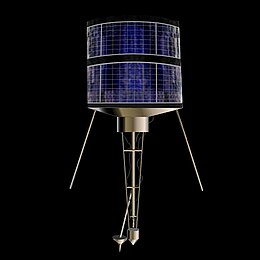cosmos.wikisort.org - Spacecraft
Kosmos-2251 (Russian: Космос-2251 meaning Cosmos 2251), was a Russian Strela-2M military communications satellite. It was launched into Low Earth orbit from Site 132/1 at the Plesetsk Cosmodrome at 04:17 UTC on 16 June 1993, by a Kosmos-3M carrier rocket.[3]·[4] The Strela satellites had a lifespan of 5 years, and the Russian government reported that Kosmos-2251 ceased functioning in 1995.[5] Russia was later criticised by The Space Review for leaving a defunct satellite in a congested orbit, rather than deorbiting it. In response, Russia noted that they were (and are)[6] not required to do so under international law.[7][8] In any case, the KAUR-1 satellites had no propulsion system, which is usually required for deorbiting.[9][10]
 A Strela-2M communication satellite, similar to Kosmos 2251. | |
| Mission type | Military communication |
|---|---|
| Operator | VKS |
| COSPAR ID | 1993-036A |
| SATCAT no. | 22675 |
| Mission duration | 5 years (nominal mission) |
| Spacecraft properties | |
| Spacecraft type | Strela-2M |
| Bus | KAUR-1[1] |
| Manufacturer | Reshetnev |
| Launch mass | 900 kg |
| Start of mission | |
| Launch date | 16 June 1993, 04:17 UTC |
| Rocket | Kosmos-3M |
| Launch site | Plesetsk, Site 132/1 |
| End of mission | |
| Last contact | 1995 |
| Decay date | 10 February 2009 (destroyed in space) |
| Orbital parameters | |
| Reference system | Geocentric[2] |
| Regime | Low Earth |
| Perigee altitude | 783 km |
| Apogee altitude | 821 km |
| Inclination | 74.0° |
| Period | 101.0 minutes |
Destruction
At 16:56 UTC on 10 February 2009,[11] it collided with Iridium 33 (1997-051C), an Iridium satellite,[12] in the first major collision of two satellites in Earth orbit. The Iridium satellite, which was operational at the time of the collision, was destroyed, as was Kosmos-2251.[13] NASA reported that a large amount of debris was produced by the collision.[14][15]
See also
- Kessler Syndrome
References
- Brian Weeden (10 November 2010). "2009 Iridium-Cosmos Collision Fact Sheet" (PDF). Secure World Foundation.
- https://nssdc.gsfc.nasa.gov/nmc/spacecraft/displayTrajectory.action?id=1993-036A - 27 February 2020
- Wade, Mark. "Strela-2M". Encyclopedia Astronautica. Archived from the original on 10 July 2016. Retrieved 25 March 2019.
- Wade, Mark. "Kosmos-11k65". Encyclopedia Astronautica. Archived from the original on 11 October 2016. Retrieved 11 February 2009.
- "First Satellite Collision Called Threat in Space". The Moscow Times. 13 February 2009.
- Chelsea Muñoz-Patchen (2018). "Regulating the Space Commons: Treating SpaceDebris as Abandoned Property in Violation of the Outer Space Treaty". Chicago Journal of International Law. 19: 233.
- Brian Weeden (23 February 2009). "Billiards in Space". The Space Review.
- Michael Listner (13 February 2012). "Iridium 33 and Cosmos 2251 three years later: where are we now?". The Space Review.
- Игорь Королев. Авария на $50 млн // Ведомости, № 26 (2296), 13 февраля 2009
- Brian Harvey; Olga Zakutnyaya (2011). Russian Space Probes: Scientific Discoveries and Future Missions. Springer Science & Business Media. ISBN 978-1441981509.
- Iannotta, Becky (11 February 2009). "U.S. Satellite Destroyed in Space Collision". Space.com. Retrieved 11 February 2009.
- "Office for Outer Space Affairs". United Nations. Retrieved 12 February 2009.
Reported as colliding with Iridum 33 (1997-051C) on 10/02/2009
- "Russian and US satellites collide". BBC News. 12 February 2009. Retrieved 12 February 2009.
Russia has not commented on claims that the satellite was out of control.
- "2 orbiting satellites collide 500 miles up". Associated Press. 11 February 2009. Retrieved 11 February 2009.
- "U.S. Space debris environment and operational updates" (PDF). NASA. 7 February 2011. Retrieved 25 August 2010.
На других языках
- [en] Kosmos 2251
[ru] Космос-2251
Космос-2251 — российский военный спутник связи типа «Стрела-2М» № 51, запущенный 16 июня 1993 года в 4:17 UTC с космодрома Плесецк ракетой-носителем «Космос 11К65М». Спустя два года был выведен из эксплуатации. 10 февраля 2009 года в 4:55 UTC, находясь на высоте 790 километров над территорией северной части Сибири (полуостров Таймыр) столкнулся с американским спутником Iridium-33 — первое подобное происшествие такого рода в истории космонавтики. Образовалось приблизительно 600 осколков размером более 5 см и несколько тысяч[1] мелких.Другой контент может иметь иную лицензию. Перед использованием материалов сайта WikiSort.org внимательно изучите правила лицензирования конкретных элементов наполнения сайта.
WikiSort.org - проект по пересортировке и дополнению контента Википедии